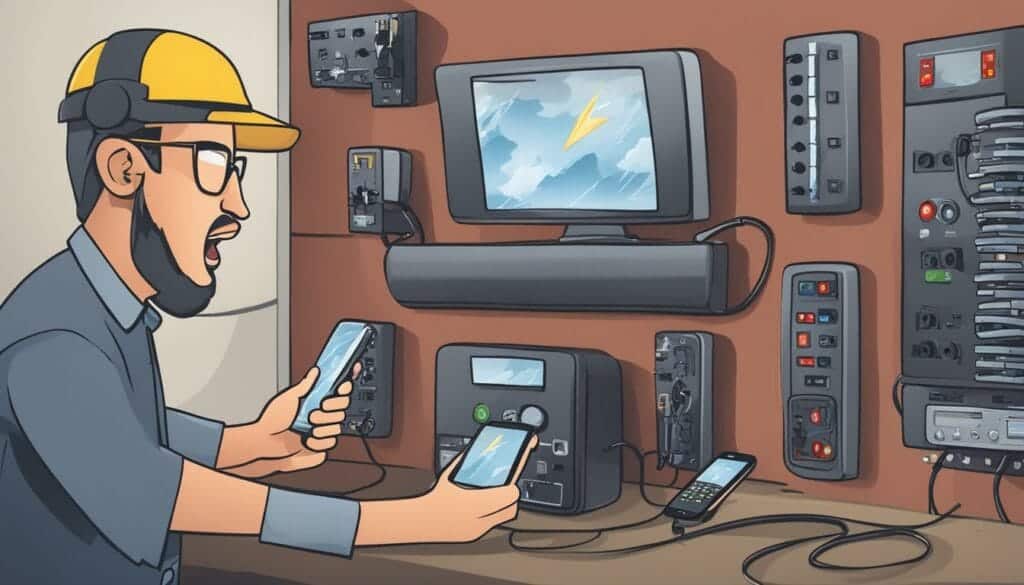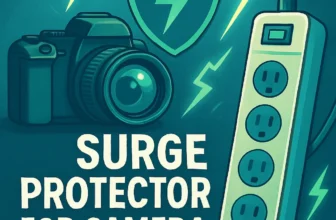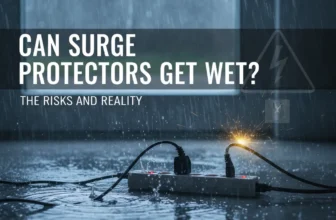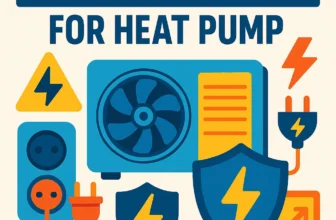Published By: Marc Edwards | Last updated on July 4, 2025 and reviewed by Editorial Team

Surge protectors are essential devices that protect electronic equipment from damaging voltage spikes or surges. Damaging voltage surges can occur due to lightning strikes or when large appliances like air conditioners turn on.
These surges can cause permanent damage to your valuable electronics. Hence choosing the right surge protector is the critical first step in protecting your connected devices.
As you may already know, many types of surge protectors are available on the market, each offering different options and levels of protection.
Whether you’re looking for a power strip surge protector, a wall-mounted surge protector, or a whole-house surge protector, it’s important to consider a whole suite of factors and functionalities before making your purchase decision.
Types of Surge Protection Devices: 4 Classifications [Level of Protection] You Should Know
When it comes to safeguarding your valuable electronic devices and appliances from power surges, not all surge protectors are created equal. To provide your home with the best protection, it is important to understand the different types of surge protectors and how they function.
In this section, we’ll delve into the various options, including:
- standard wall-mounted and DIN-mounted surge protection module (Type 4)
- power strips with surge protection, plug-in surge protectors (Type 3)
- distribution panel surge protectors (Type 2)
- service entrance surge protectors (Type 1)
1. Surge Protection Modules (Type 4)
Type 4 surge protectors, also known as surge protection modules, provide a distinct approach to surge protection compared to Type 3 protectors. Tailored for industrial settings and diverse applications (PLCs and motors drives, etc), these devices are available in standard wall-mounted and DIN-mounted configurations.
Type 4 surge protectors can be wired into industrial and commercial equipment cabinets to safeguard devices housed within. An example of a type 4 surge protection device can be seen here.
If you are a homeowner, there is no need to consider a type 4 for your household appliances and electrical devices.
Advantages: Type 4 SPDs offer targeted protection for individual devices or systems, reducing the risk of damage and downtime. They are versatile and available in various modular configurations suitable for industrial and commercial applications. Additionally, their point-of-use placement ensures efficient protection where it’s needed most.
Limitations: While Type 4 SPDs provide effective protection for specific devices, they may not offer comprehensive coverage against all surge events, especially those originating from external sources like lightning strikes. Additionally, since they are typically designed for industrial and commercial use, they may not be suitable for residential applications. Regular maintenance and monitoring are also necessary to ensure continued effectiveness.
Use Cases: Applications for Type 4 SPDs are typically found in various industrial and commercial settings where protecting sensitive electronic equipment is crucial. They are commonly employed in manufacturing facilities, data centers, telecommunications infrastructure, and commercial buildings to safeguard devices such as control systems, communication equipment, computer servers, and electronic instrumentation. Their modular design and point-of-use placement make them adaptable to a wide range of equipment and environments, offering tailored surge protection solutions where they are needed most.
2. Plug-In Surge Protectors (Type 3)
Plug-in surge protectors, also known as Type 3 surge protectors, are compact devices designed to plug directly into individual electrical outlets or power strips. They provide localized protection for specific devices or circuits.
Advantages:
- Ease of Installation: Plug-in surge protectors are user-friendly and can be installed by homeowners without professional assistance.
- Localized Protection: They are highly accessible and offer surge protection to connected devices or equipment.
- Cost-Effective: Type 3 surge protectors are budget-friendly, making them a practical choice for homeowners.
Limitations:
- Limited Coverage: These protectors provide localized protection and may not be effective against severe surges or direct lightning strikes.
- Finite Lifespan: Like power strips, plug-in surge protectors have a finite lifespan and may need replacement after absorbing surges.
Use Cases: Type 3 surge protectors are suitable for protecting small electronics, such as computers, televisions, and appliances. They are an excellent choice for areas with moderate surge risks.
3. Distribution Panel Surge Protectors (Type 2)
Type 2 surge protectors, also known as Distribution Panel Surge Protective Devices (SPDs), are designed to be installed at the distribution panel or main breaker panel of a building. They are whole-house surge protectors that protect downstream electrical circuits, including subpanels and branch circuits.
Advantages:
- Comprehensive Protection: Type 2 protectors offer robust protection for your home’s electrical distribution system, safeguarding all circuits connected to the distribution panel.
- Moderate Cost: They are more budget-friendly than service entrance surge protectors (Type 1) while providing broad protection.
Limitations:
- Professional Installation: Type 2 surge protectors may require professional installation due to their connection to the main distribution panel.
- Limited to Distribution Panel: While they protect multiple circuits, they do not offer protection for the entire home, as they may not guard against surges entering through the main electrical service.
Use Cases: Type 2 surge protectors are ideal for homeowners seeking to safeguard their entire house, particularly in regions with moderate surge risks.
4. Service Entrance Surge Protectors (Type 1)
Type 1 surge protectors, also known as Service Entrance Surge Protective Devices (SPDs), are designed to be installed at the main electrical service entrance, offering protection for the entire electrical system of a building.
Advantages:
- Maximum Protection: Type 1 protectors offer the highest level of protection, guarding against severe external surges, such as direct lightning strikes and utility power fluctuations.
- Broad Coverage: They protect the entire home, designed to shield all connected devices and appliances.
Limitations:
- Professional Installation: Installation of Type 1 surge protectors requires a qualified electrician due to their connection to the main electrical service.
- Cost: They are more expensive than other surge protection options due to their comprehensive protection and professional installation.
Use Cases: Type 1 surge protectors are essential for homes in areas prone to frequent lightning strikes or severe electrical disturbances. They provide the most robust protection for your home electronics and appliances.
Understanding the different types of surge protectors empowers homeowners to make informed decisions about protecting their valuable electronic devices. Your choice will depend on your specific needs, budget, and the level of surge risk you face.
Protecting your electronics is not just a matter of convenience; it’s a safeguard against unforeseen events that can save you money and frustration in the long run.

A tech analyzing voltage across different types of surge protectors
Determine the Types of Surge Protectors Outlets You Need
When considering the types of surge protection devices to buy, it’s important to consider the type(s) of outlets you might need.
Different devices require different types of outlets, and ensuring compatibility is essential for optimal protection.
- USB ports (USB A / USB C)
- RJ45 ports (Ethernet)
- RJ11 ports (for telephone lines)
- Coaxial ports (for cable or satellite connections)
Most surge protectors have USB charging ports, including the newer USB-C ports. They are suitable for charging smartphones, tablets, and other USB-powered devices.
In addition to USB ports, some surge protectors offer specialized outlets to protect specific devices.
These include outlets for TVs (coaxial), telephones (RJ11), and networks (RJ45). If you have devices that require such connections, ensure the surge protector you choose has the corresponding outlets.
Worth NotingIt’s important to note that surge protectors and power strips are different.
Power strips only provide additional power outlets whereas surge protectors offer an added layer of protection against voltage fluctuations, ensuring the safety of your electronics.
Some surge protectors come with advanced features like fireproof technology and safe-fail protection.
Additional Features and Considerations
- Fireproof technology: Certain surge protectors are equipped with materials that can resist and prevent fires caused by electrical faults.
- Safe-fail protection: In the event of a power surge that exceeds the maximum protection capacity of the surge protector, safe-fail protection shuts down the surge protector, ensuring that no further voltage is allowed to pass through.
- Joules of protection: Surge protectors are assigned a joule rating, which indicates their maximum ability to absorb energy from surges. The higher the joule rating, the more energy the surge protector can handle without compromising its protective abilities.
Remember, when selecting a surge protector, it’s important to consider not only the level of protection it provides but also any additional features that may enhance its effectiveness and safety.
Now that you have a clear understanding of how surge protectors work and the additional features they offer, you can confidently choose the right surge protector to safeguard your valuable devices.
| Good to Have Features | Description |
| Fireproof Technology | Prevents fires caused by electrical faults by using fire-resistant materials. |
| Safe-Fail Protection | Shuts down the surge protector if a power surge exceeds its protection capacity to prevent further voltage from passing through. |
| Joules of Protection | Indicates the surge protector’s maximum ability to absorb energy from surges, with higher ratings offering greater protection. |
Table: Surge Protector Outlet Types
| Outlet Type | Function | Example Devices |
| USB | Charging | Smartphones, tablets |
| Coax | TV | Televisions |
| RJ11 | Telephone | Landline phones, fax machines |
| RJ45 | Network | Computers, routers |
Choosing the appropriate surge protector through informed decision-making can improve your electronic devices’ safety and lifespan. If you have any questions or require additional assistance, feel free to reach out to a technical support team. Safeguard your devices and gain peace of mind knowing they are protected from power surges.
Frequently Asked Questions
| Question | Answer |
| How do whole-house surge protectors differ from power strips? | Whole-house surge protectors are installed at the main electrical panel, protecting the entire home. Power strips protect specific devices or equipment. |
| Can you explain the distinctions between plug-in and rack-mounted surge protectors? | Plug-in surge protectors are portable and plugged into outlets, while rack-mounted ones are designed for use in server racks and network installations. |
| Are there specialized surge protectors for specific electronic devices? | Yes, some surge protectors are designed for specific equipment like computers or home theaters, providing tailored protection. |
| What are the key characteristics of outdoor surge protectors? | Outdoor surge protectors are weatherproof and built to withstand environmental elements, safeguarding devices in external installations. |
| How do surge protector types vary in terms of response time? | The response time of surge protectors can vary, with some offering faster reactions to surges, which may be crucial for sensitive equipment. |
| Are there surge protectors designed for industrial or commercial use? | Yes, industrial and commercial surge protectors are available. They offer robust protection for larger-scale electrical systems and equipment. |
| What are the advantages and disadvantages of hardwired surge protectors? | Hardwired surge protectors provide permanent protection but may require professional installation. Portable ones offer flexibility but may need replacement over time. |
| Which type of surge protector is best for safeguarding a home office? | Type 3 Surge protectors are designed for computers and other electronics. They offer ideal protection for a home office with sensitive equipment. |
| Can you provide recommendations based on specific needs like lightning protection or noise reduction? | Specific surge protectors are designed to address unique needs, such as lightning protection or noise filtering; recommendations should align with the specific requirements. Drop us a note if you need recommendations. |








